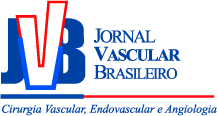Avaliação da saturação tecidual de oxigênio durante o sintoma claudicante em pacientes com doença arterial periférica
Tissue oxygen saturation assessment during claudication symptoms in patients with peripheral arterial disease
João Antônio da Silva Junior; Débora Úrsula Fernandes Souza; Daniela Rodrigues Ferreira; Mariane Cassia Paixão Valeriano; Raquel Ferreira Santos; Raquel Rodrigues Britto; Danielle Aparecida Gomes Pereira
Resumo
Palavras-chave
Abstract
Keywords
References
Garcia LA. Epidemiology and pathophysiology of lower extremity peripheral arterial disease. J Endovasc Ther. 2006;13(1^sSupl 2):II3-9.
Silva R, Consolim-Colombo F. Aspectos relevantes para identificação da claudicação intermitente. Acta Paul Enferm. 2011;24(3):426-9.
Bradberry JC. Peripheral arterial disease: pathophysiology, risk factors, and role of antithrombotic therapy. J Am Pharm Assoc. 2003;2004(44):S37-45, quiz S44-5.
Vaz C, Duarte V, Santos AR. Doença arterial periférica e qualidade de vida. Angiol Cir Vasc. 2013;9(1):1-7.
McDermott MM, Guralnik JM, Albay M, Bandinelli S, Miniati B, Ferrucci L. Impairments of muscles and nerves associated with peripheral arterial disease and their relationship with lower extremity functioning: the InCHIANTI Study. J Am Geriatr Soc. 2004;52(3):405-10.
Atkins L, Gardner AW. The relationship between lower extremity functional strength and severity of peripheral arterial disease. Angiology. 2004;55(4):347-55.
Breek J, Hamming J, Vries J, Aquarius AEA, Henegouwen D. Quality of life in patients with intermittent claudication using The World Health Organisation (WHO) questionnaire. Eur J Vasc Endovasc Surg. 2001;21(2):118-22.
Creager MA, Belkin M, Bluth EI. 2012 ACCF/AHA/ACR/SCAI/SIR/STS/SVM/SVN/SVS key data elements and definitions for peripheral atherosclerotic vascular disease: a report of the American College of Cardiology Foundation/American Heart Association Task Force on Clinical Data Standards (Writing Committee to Develop Clinical Data Standards for Peripheral Atherosclerotic Vascular Disease). Circulation. 2012;125(2):395-467.
Flu HC, Tamsma J, Lindeman J, Hamming J, Lardenoye J. A systematic review of implementation of established recommended secondary prevention measures in patients with PAOD. Eur J Vasc Endovasc Surg. 2010;39(1):70-86.
Manfredini F, Malagoni AM, Mandini S. Near-infrared spectroscopy assessment following exercise training in patients with intermittent claudication and in untrained healthy participants. Vasc Endovascular Surg. 2012;46(4):315-24.
Malagoni AM, Felisatti M, Mandini S. Resting muscle oxygen consumption by near-infrared spectroscopy in peripheral arterial disease: A parameter to be considered in a clinical setting?. Angiology. 2010;61(6):530-6.
Manfredini F, Conconi F, Malagoni AM. Training guided by pain threshold speed: effects of a home-based program on claudication. Int J Angiol. 2004;23(4):379-87.
Manfredini F, Malagoni AM, Mascoli F. Training rather than walking: the test in-train out program for home-based rehabilitation in peripheral arteriopathy. Circ J. 2008;72(6):946-52.
Colier W, Meeuwsen I, Degens H, Oeseburg B. Determination of oxygen consumption in muscle during exercise using near infrared spectroscopy. Acta Anaesthesiol Scand Suppl. 1995;107:151-5.
Comerota AJ, Throm R, Kelly P, Jaff M. Tissue (muscle) oxygen saturation (StO2): a new measure of symptomatic lower-extremity arterial disease. J Vasc Surg. 2003;38(4):724-9.
Ritti-Dias RM, Gobbo LA, Cucato GG. Translation and validation of the walking impairment questionnaire in Brazilian subjects with intermittent claudication. Arq Bras Cardiol. 2009;92(2):136-49.
Souza AC, Magalhães CL, Teixeira-Salmela LF. Adaptação transcultural e análise das propriedades psicométricas da versão brasileira do Perfil de Atividade Humana. Cad Saude Publica. 2006;22(12):2623-36.
Buchalla CM. A classificação internacional de funcionalidade, incapacidade e saúde. Acta Fisiátr.. 2003;10(1):29-31.
Fix AJ, Daughton DM. Human activity profile: professional manual. 1988:25.
Daughton DM, Fix AJ, Kass I, Bell CW, Patil KD. Maximum oxygen consumption and the ADAPT quality-of-life scale. Arch Phys Med Rehabil. 1982;63(12):620-2.
Ferrari M, Muthalib M, Quaresima V. The use of near-infrared spectroscopy in understanding skeletal muscle physiology: recent developments Philos Trans A Math Phys. Eng Sci. 1955;2011(369):4577-90.
Cunha-Filho IT, Pereira DAG, Carvalho AM, Campedeli L, Soares M, Sousa Freitas J. The reliability of walking tests in people with claudication. Am J Phys Med Rehabil. 2007;86(7):574-82.
Monteiro DP, Britto RR, Carvalho MLV, Montemezzo D, Parreira VF, Pereira DAG. Shuttle walking test como instrumento de avaliação da capacidade funcional: uma revisão da literatura. Ciência & Saúde. 2014;7(2):92-7.
Cunha-Filho IT, Pereira DAG, Carvalho AMB, Campedeli L, Soares M, Freitas JS. Confiabilidade de testes de caminhada em pacientes claudicantes: estudo piloto. J Vasc Bras. 2008;7(2):106-11.
Singh SJ, Morgan MD, Scott S, Walters D, Hardman AE. Development of a shuttle walking test of disability in patients with chronic airways obstruction. Thorax. 1992;47(12):1019-24.
Hiatt WR, Rogers RK, Brass EP. The treadmill is a better functional test than the 6-minute walk test in therapeutic trials of patients with peripheral artery disease. Circulation. 2014;130(1):69-78.
McCully KK, Halber C, Posner JD. Exercise-induced changes in oxygen saturation in the calf muscles of elderly subjects with peripheral vascular disease. J Gerontol. 1994;49(3):B128-34.
Ubbink DT, Koopman B. Near-infrared spectroscopy in the routine diagnostic work-up of patients with leg ischaemia. Eur J Vasc Endovasc Surg. 2006;31(4):394-400.
Seifalian AM, Atwal A, White S, Mikhailidis DP, Baker D, Hamilton G. A role for near infrared spectroscopy in the assessment of intermittent claudication. Int Angiol. 2001;20(4):301-6.
McCully KK, Hamaoka T. Near-infrared spectroscopy: what can it tell us about oxygen saturation in skeletal muscle?. Exerc Sport Sci Rev. 2000;28(3):123-7.
Cheatle TR, Potter LA, Cope M, Delpy DT, Smith PD, Scurr JH. Near infrared spectroscopy in peripheral vascular disease. Br J Surg. 1991;78(4):405-8.
Wolf U, Wolf M, Choi JH. Localized irregularities in hemoglobin flow and oxygenation in calf muscle in patients with peripheral vascular disease detected with near-infrared spectrophotometry. J Vasc Surg. 2003;37(5):1017-26.
Kooijman HM, Hopman MT, Colier WN, van der Vliet JA, Oeseburg B. Near infrared spectroscopy for noninvasive assessment of claudication. J Surg Res. 1997;72(1):1-7.



